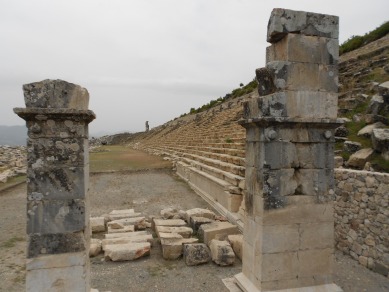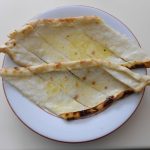“Lake Castle” Population: 16,000
Old name: Kabala
Midway between Burdur and Fethiye, Gölhisar is a dusty small town of little distinction which is, nonetheless, home to one of Turkey’s most impressive yet least visited archaeological sites.
The ruins of Kibyra lie a mere 2km beyond the vast and ugly Çeşme Çarşı Cami (mosque). They’re within walking distance of town but since the road runs steadily uphill you might want to take a taxi on a hot day. There’s nowhere to buy water at the site.
Backstory
The ancient town was originally founded as Kabala at the point where Caria, Lydia, Phrygia and Psidia met and at a major junction for east-west and north-south trade routes by people who may have spoken a Luwian language. Later it became part of the Kingdom of Pergamum and formed a federation, the Kabalis Tetrapolis, with neighbouring Boubon, Balboura and Oinanda.
Eventually the other three cities became part of the Lycian League while Kibyra became Roman. Everything to be seen at the site today stems from after the Roman occupation and especially from the period of rebuilding that took place after a devastating earthquake in 23 AD.
Around the site
As the road winds up into the hills you will pass, on the left, a cobbled street that rises gradually upwards with scattered tombs on either side of it. It was in this necropolis area that the magnificent friezes depicting gladiators in combat in Burdur Museum were found.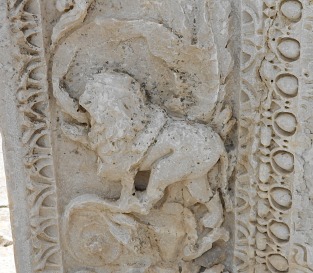
Shortly after that you will come to a gate on the left, unmanned for the time being, that leads through to the main site.
Immediately you find yourself standing in front of one of the most spectacular surviving stadia in the country, certainly a match for the ones at Afrodisias and Arykanda. Two hundred metres long, it could probably have seated around 10,000 spectators who came here to watch athletics matches and gladiatorial combat. On one side of the stadium the seats rose up in 21 tiers against the hillside while on the opposite side there were only five tiers, allowing the people on the other side to look over them to the plains beyond.
The remains of a martyrium, or monumental tomb, stand near the entrance to the stadium.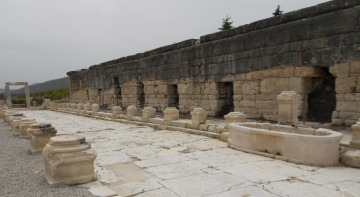
A track rises behind the stadium to emerge at the ruins of a basilican church with rich marble paving stones, a synthronon, a baptistry and a variety of burial places. It looks as if some of its columns will probably be re-erected in due course.
Beyond the church you reach the agora (market place), its paving stones still intact and with a bath-like marble basin at one end, still with its terracotta piping intact. The street is lined on one side with plinths for statues but on the other there is a steep wall which dates from a later period when one side of the agora was more or less fortified.
From here the marble-paved main street runs downhill back towards the stadium. At the top a single marble arch has been re-erected. This is covered with elaborate carvings of foliage and what look like tiny lions; it reminded me of the even more elaborate arch from Magnesia ad Meandrum in the İstanbul Archaeology Museum.
As you climb the hill you will see steps leading up on the left the delightfully reconstructed Tholos or Nymphaeum, a decorative fountain only rediscovered in 2016.
The track keeps on climbing until suddenly you see ahead of you two enormous buildings more or less level with each ither that are astonishingly well preserved. The first is the theatre which is partially built into the hillside but also has a frame that stands clear of it. It seems to have been able to seat a capacity audience of about 9,000. At a later stage a church was built in front of it.
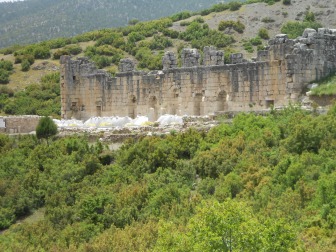 The second of the buildings was the Bouleterion (Council House/Odeon) which seems to have doubled up as a smaller theatre and a court house as and when needed. A magnificent mosaic showing the head of the Gorgon Medusa was found here; this is uncovered from the first week of May to the first week of November each year.
The second of the buildings was the Bouleterion (Council House/Odeon) which seems to have doubled up as a smaller theatre and a court house as and when needed. A magnificent mosaic showing the head of the Gorgon Medusa was found here; this is uncovered from the first week of May to the first week of November each year.
Right beside the Bouleterion are the remains of a bathhouse with a hypocaust heating system and terracotta tiles intact if somewhat roughly restored. Here, too, are the remains of a small temple to the emperors as deities.
Returning to the centre of town you will notice pieces of marble jutting out of the silt beside the road, suggesting that much more of ancient Kibyra still awaits discovery.
In the tea garden in the town centre two marble lions and assorted pieces of marble masonry have been gathered as decoration; more can be seen in the tea garden further along the main road at Altınyayla, a dreary little place utterly overwhelmed by its enormous and ugly Merkez Cami.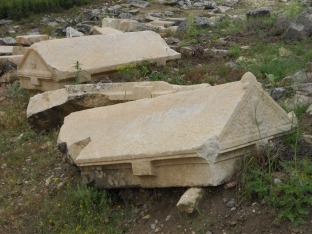
Sleeping
Although there is a hotel in Gölhisar (Kibyra Otel) you’re probably better off visiting from either Burdur or Fethiye.
Transport info
Half a dozen daily buses run between Fethiye and Burdur, transiting Gölhisar.
The gap between buses leaves just about enough time to take a quick look at Kibyra although you’ll have a better time of it if you have your own transport and can linger to do full justice to the site.
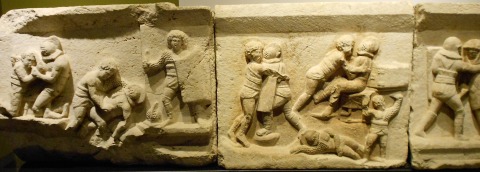 Kibyra’s gladiators in Burdur Museum
Kibyra’s gladiators in Burdur Museum
